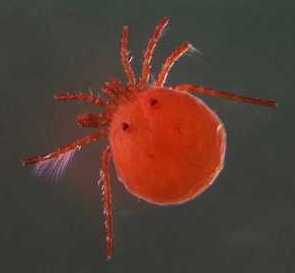Home → Water Quality → Monitoring & Reporting → Biomonitoring → Sampling & Analysis → Macroinvertebrate Types → Mites
 Water Mites (Acariformes)
Water Mites (Acariformes)
Water mites are more closely related to land-dwelling spiders, ticks, scorpions, and mites than they are to other aquatic macroinvertebrates. Like spiders, water mites have 4 pairs of legs. The round body is mostly comprised of the abdomen, with a very small head (the cephalothorax). At a typical diameter of 2-3mm, water mites are very small.
Water mites reproduce sexually, and undergo a complicated lifecycle involving three juvenile stages before becoming adults. Because juvenile mites spend most of their time in inert stages attached to either a host animal or plant, mites that are sampled during biological monitoring are usually adults.
Most water mites are predators that eat zooplankton or other invertebrate larvae. Some are parasitic, while others eat plants or detritus. Parasitic mites and parasitic juvenile mites generally feed on aquatic insects, although some feed on mussels. Parasitism by mites is usually non-lethal, although in high numbers they can damage the health of their host. While they are most abundant and diverse amongst aquatic plants in shallow areas of ponds, lakes, swamps, marshes, and bogs, water mites can be found in all freshwater habitats. Some types can even thrive in the riffles of fast flowing streams.
Water mites breathe by absorbing dissolved oxygen all over their body surface. They can survive in dissolved oxygen concentrations as low as 1 part per million, making them potentially well suited to live in waters polluted by nutrients. As a group, water mites exist in a wide range of pollution levels, although individual species range from sensitive to somewhat tolerant of pollution.
Picture key
Photo: A water mite (Hydrachna sp.)
Source: The Water Mites Of North America Project
Bibliography
Voshell, Jr., J. Reese; illustrated by Amy Bartlett Wright. 2002. A Guide to Common Freshwater Invertebrates of North America. Blacksburg (VA): The McDonald & Woodward Publishing Company. 442 p